

Jerome Domurat interview
By Scott Stilphen
(2002, 2007)
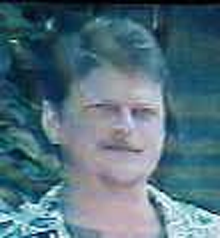
Q: What is your educational background?
Jerome Domurat: My background and education was in animation, not in graphic design. I never made it to the world of ray trace special film effects, as I was sidetracked by the real-time instant fun activity of videogames. My major in college was narrowcast video and animation. So my interest in computers was the same.
Q: How did that translate to designing games on the 2600?
Jerome Domurat: Atari, at the time, was beginning to recognize that the games need to be visually active and that it was difficult to portray some animations in such low res. There were a few of us who had some animation background and tried to apply that knowledge to the technology. It was quite a struggle making something look fluid in so few pixels. There were basically no tools and some of the 'animating' I did was written directly in hex into the game, compiled and assembled, and then we would see if it worked or not. Though it was a lot of effort, the results still weren't spectacular but at least they were acceptable.
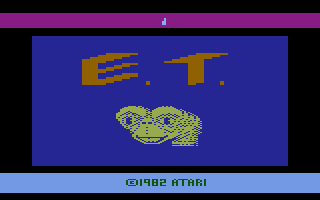 Q: How did you get your start at Atari?
Q: How did you get your start at Atari?
Jerome Domurat: I had been working on computer software for museum exhibits at the American Museum of Science & Energy in Oak Ridge, Tennessee. We'd been developing Commodore 64 and Atari 800 exhibit quiz games. A few of the programmers I was working with had been hired by Atari. While I was in San Francisco for a conference, I went to visit one of the programmers at Atari. While I was there he suggested that I check out Atari and see what jobs were available. They were in a tremendous hiring mode. At that point I didn't think I was that interested. But after spending an afternoon talking to Marilyn Theurer in the VCS group, I was interested. I could see that they were interested in more complex adventure games, which is the type of game I enjoy working on. I got an offer from Atari and they relocated me to the West coast. I worked in the VCS engineering group from November 1981 until Jack Tramiel took over Atari in 1984. Then I worked for Jack's Atari for 2 years, leaving in 1986 to go work at Apple.
Q: What program(s) did you use?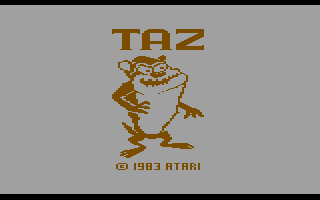
Jerome Domurat: I worked at Atari on development tools for animation. Dave Theurer had written a wonderful program on the Atari 800 (Graphics Stamp Design Aid) to create animations. It used a joystick controller and allowed you to draw with 16 colors and then see the animated sequence. I don't recall what the acronym stood for. There were a number of software graphic and animation tools developed. Visual development went from typing hex code straight into the source to being able to cut & paste the data from floppy to source. Everyone had a "Holy Grail" quest for finding easy prototyping and hence quick development of new game ideas. Writing a game from scratch took somewhere between 3 to 6 months.
Dave also created NeoChrome for the ST version of Star Raiders. I had a special (in-house) video module for it just for working on that game.
Q: What was the creative process like?
Jerome Domurat: I worked a lot with the engineers in brainstorming and storyboarding game ideas, and then illustrating the images for software on the 2600 and 5200 video games machines. Working closely with programmers to create game play graphics and backgrounds, I was involved in software development from initial conception, storyboarding, to final game graphics and implementation.
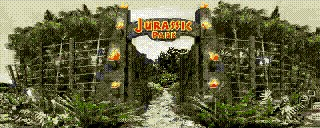 Q: You also worked on Sega's Jurassic Park?
Q: You also worked on Sega's Jurassic Park?
Jerome Domurat: I was responsible for directing the design and development process for Jurassic Park Sega CD. Included the hiring of talent, defining roles and job descriptions, and the process. The Jurassic Park team created an action-adventure “non shoot em up” game that is different than most video games. Using a first person adventure style format, the game contained video messages and dinosaur field guide information contributed by paleontologist, Dr Robert Bakker.
Q: Do you recall any titles that you worked on that were never released?
Jerome Domurat: There was such a wide range of unreleased products that I haven't tried to list them, but I had worked on a drawing program for the Atari 800 called Sketch that was never commercially distributed.
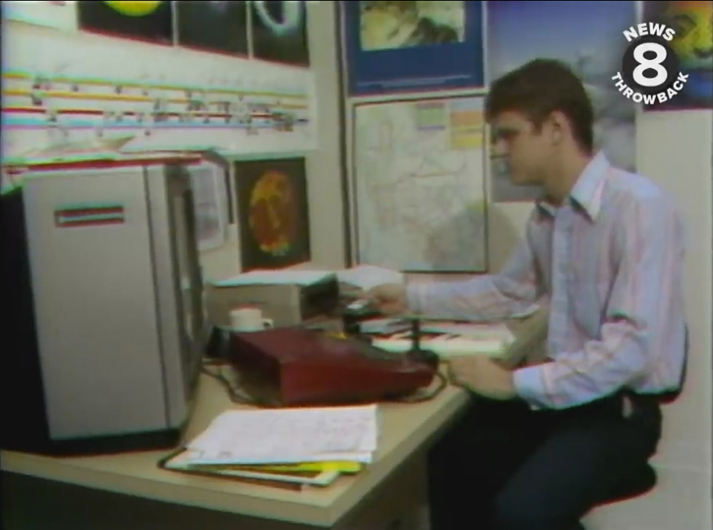
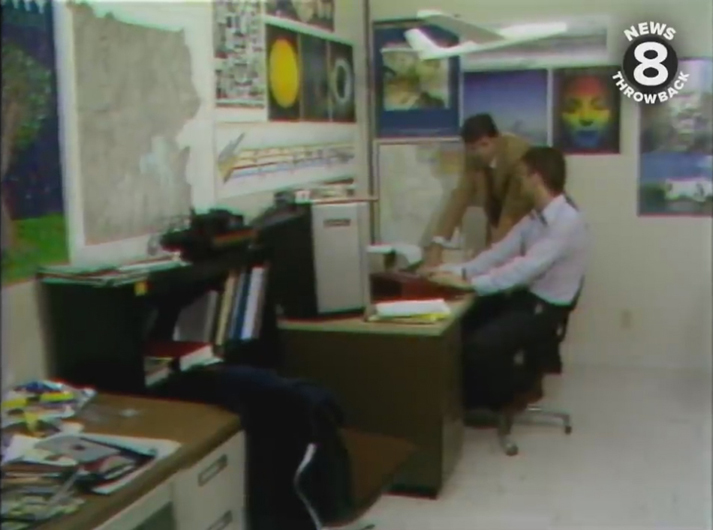
Screenshots from CBS Channel 8 1982 of Jerome Domurat at his desk. Note
the red Atari 800 computer used for creating game animations.
Atari CED in-house promo - 2nd Quarter 1983 new releases. Tape courtesy of Alan Murphy.
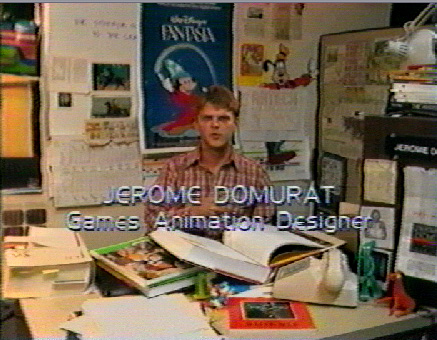
Screenshot of Jerome Domurat from an Atari CED in-house promo, at his desk.
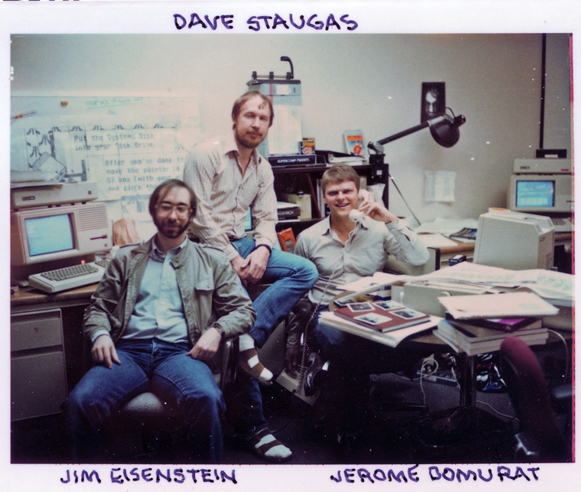
Group photo with Dave Staugas and
Jim Einsenstein.
Q: I recently found footage of some of the people in the Consumer division, talking about what games they were working on at that point, and there was some of you in your office. This was late '83...
Jerome Domurat: At one point (around '83) Atari had plans for an Atari TV channel. Being they had ties with Warner Brothers, they had a film crew come in a tape footage about what each person was working on.
I was flown to NYC one time to work on animation for an E.T. commercial. I was always after them to get a copy of it but I never did. Stuff like that always interested me.
I remember when Larry Kaplan came back to Atari, he was in management, which allowed him to eat in the executive's restaurant that was in Atari. I think this was something that Ray Kassar created and was only used by people in management, or when any Warner brass or people like Steven Spielberg came to visit. Larry would sometimes stop by my office
and ask me to lunch, so I always had a tie in my office so that I could get in! Although some people didn't care for it, I thought the food served there was very good.
There was a group next to my office, headed by Sherman Kennedy, who were working on developing the Atari 800 laserdisc kiosk. By then everyone had these key cards so you were only allowed in certain areas. I would always hear these strange noises coming from their office so one day I asked them what they were working on and they showed me. There were a couple Atari 800 computers torn apart and scattered around and they demonstrated how by
pressing certain keys you could access different tracks on the disk. There was also a big screen rear-projector TV which I thought had lousy picture quality, plus you had to be directly in front of it in order to see it. Because of that, their office was usually dark so that it was easier to see the TV. Sherman was also working on a vector-based computer. He had generated a cube demo on it at one point.
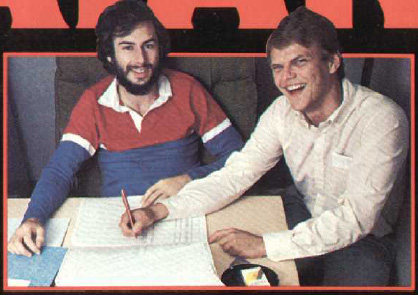
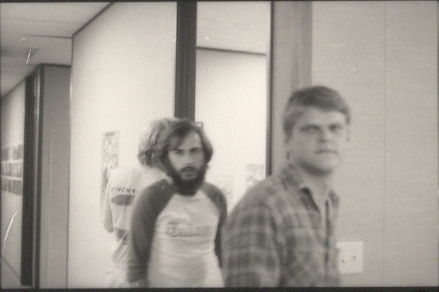
(LEFT) Howard Warshaw and Jerome in a February 1984 Electronic Fun article; (RIGHT)
Tod Frye (with back to camera), Howard, and Jerome in the halls of Atari
Q: Former alumni have talked about different ways they dealt with the new security procedures, such has simply punching through the wall to open the door :)
Jerome Domurat: The whole key card thing really caused people to become more secretive on what they were working on, for fear that their ideas would leak out and someone else would 'scoop' them. In a way, it helped create this divisiveness which resulted in all these little
groups of people. But so many of these little secret projects were never taken to market. There was a lot of wasted effort by the time Tramiel took over.
The one thing I liked about the Tramiel era was if you were told we were going to work or not work on something, that's exactly what you did. In the Kassar era, so many times I would be working on a project and someone (usually from Marketing) would stop by and tell me that project has been cancelled, and then later on someone else would stop by and ask if I was done with it! The Marketing department really drove us nuts. It became George Kiss' "job" to keep them away
from us as much as possible just so that we could get our work done.
Marketing was obsessed with games being visually appealing, but they didn't understand that if you devoted most of your resources to making a game look nice, there were very little left to make a good game with. I sometimes created hi-res screens of drawings, and invariably someone from Marketing would see a picture that I or Alan or Mimi created and get all excited, like, "Oh, we gotta make a game out of that!" not realizing that
it's essentially a drawing.
Near the end when Atari was shutting down, it was a very surreal experience to walk in and see people's desks left untouched. As with most companies, when you're fired you don't have time to clean out your desks. So much of that stuff ended up being thrown out. I remember begging Leonard Tramiel to try and save some of it because I felt it was really historical.

An early SwordQuest title screen of Mimi Doggett's that was found in Jerome Domurat's archives, dated 4-15-1982.
Q: I think that's indicative of most companies in that there isn't much thought to preserving their own history. The game company that I know of that made a real effort to document all their products was Parker Brothers. They had their own in-house museum which contained one copy of everything they ever produced. Unfortunately, when they went under, most of it disappeared :(
Jerome Domurat: One of my first jobs (before Atari) was I spent a few summers documenting items (taking photos and notes) for the Smithsonian Institute. There were many times I felt that when I opened a crate or box I was the first person to see it since it was boxed up. It was an amazing experience. As a result, I have a habit of 'documenting' everything, whether it's a photo or a journal entry.
Aside from the occasional film crews that would come through, Dave Staugas was about the only other person who took photos of the labs and offices. Most of the photos you see in Howard's Once Upon Atari came from him. I have a tape somewhere of all the local TV news stories about Atari, but Howard only wanted to use footage and pictures that he would have full control of and didn't want to get into trying to secure rights to use footage from others. I wish more photos were taken back then.
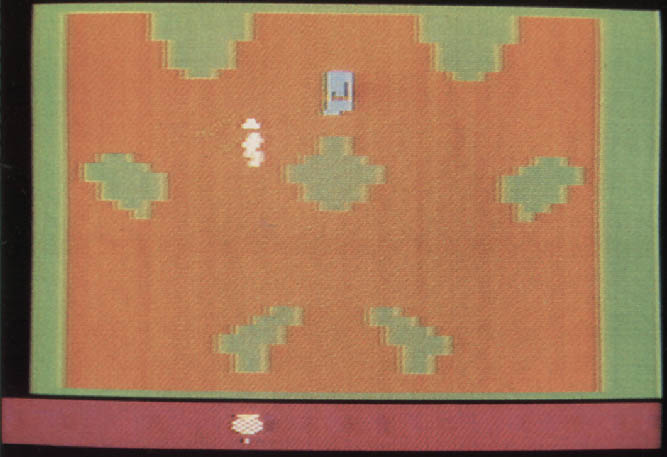
A screenshot of Jerome's initials (shown as a graphic “logo”) in Raiders of the Lost Ark's mesa field appeared in several publications on at least 8 separate instances.
Q: Speaking of Spielberg, a few years ago it was discovered that the graphics for your Easter egg initials in Raiders of the Lost Ark were removed, although some of the code for handling it is still in the program.
Jerome Domurat: I'm pretty sure what happened was, there was a problem with the game's scoring when it was added in. It might have doubled the score or something like that, so Howard was forced to remove it. We were both kinda bummed about it, so when E.T. came along we threw a bunch in :) Howard used part of the Raiders Easter egg code in E.T. though, because he was convinced that there must have been something else causing the problem, and he figured if the game testers came back with a problem, then the code was really to blame, but nothing came back about it (Ed.: As far as I know, E.T. didn't get any play-testing due to the short time Howard had to develop it.).
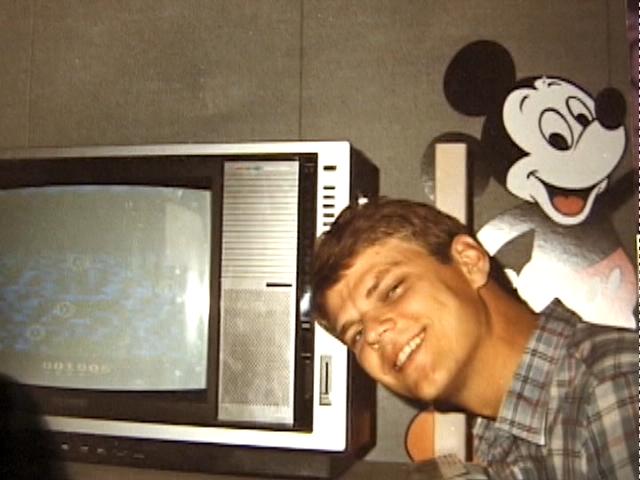
Photo of Jerome Domurat next to a TV showing a prototype version of VCS Xevious. Photo courtesy of Howard Scott Warshaw's
Once Upon Atari.
Q: One of the photos from Howard's documentary shows you next to a TV that's running a prototype version of VCS Xevious. I archived the "Atari CED in-house promo - 2nd Quarter 1983 new releases" tape from Alan Murphy, and it briefly features the game and even shows the programmer, but doesn't name him. Do you recall who that was? I know Tod Frye took over the project at some point (or rather, started
over). There's also a rumor that someone else worked on it prior to Tod, and that both gave up on it before Tod was asked to do it. In Once Upon Atari (The Agony and the Ecstacy), Tod Frye talks about working on the game and states, "They (Atari) were having a problem getting a programmer to do 2600 Xevious. Xevious was a very graphically active
game in the arcades, and the 2600 is not really a very graphically active machine. So I went home. I smoked this joint with a little psilocybin and a little cocaine in it, and all of a sudden sprang full forth in my mind exactly how to do it. And that was the moment of inspiration. And it really took 3 months of basically clerical work to code it out."
Jerome Domurat: The person demonstrating the VCS version of Xevious was in Steve Wright's group. I don't recall his name off the top of my head. I do remember that he always dressed in black and would upset a lot of the programmers when he was talking. Here is a scan of a phone list I have. What makes it a worthwhile document is that it has both first and last names. Note the date is Nov. 10 of 1982. I had been there a year at that point. But, the greatest influx of new employees occurred in the spring of 1983. Generally all the internal memos just had last names on them. His name may be on this list, as there's only a few that I don't recall who they were. Then again, he may not be on this list (Ed.: The person's name was later found to be Stephan Keith, thanks to confirmation from Suki Lee and Carla Meninsky's husband, Mike Ekberg. From Mike: "He looks like a guy that Carla hired at Sun, I think his name was Stephan Keith. I can't remember if Carla knew him from Atari. If that is him, he is/was a bit of a weird duck." From Suki: "Now that I hear the name, I think this may be the guy.")
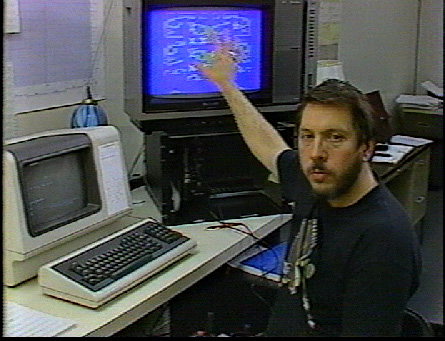
Screenshot of Stephan R. Keith from an Atari CED in-house promo, talking about VCS Xevious.
Q: Do you recall doing anything different for PAL versions of games that you worked on?
Jerome Domurat: I did most of the VCS PAL conversions, which was something most programmers felt was a mundane task and not interesting enough for them to do. I had a conversion chart for the colors and after a while I could convert the codes in my head. I also had to adjust the timing so that the PAL version would play the same way as the NTSC, but there were probably a few that didn't have the exact same timing. If you look at the code of many of those PAL games, you'll probably see a lot of No Op codes :) That was usually how we adjusted the timing. It was such a laborious task that I once tried to write a script that would handle adding them to the code, but I could never get it to work right.
Q: I know some of the PAL versions done by GCC are much less colorful than their NTSC counterparts, probably because it was too time-consuming to change every single color, so they simply left a lot of them out.
Jerome Domurat: For being a multi-million dollar company, it always amazed me how incredibly lo-tech some things were done at Atari. Company memos had professional letterheads but the actual text was often printed up with an Atari 800 that was cut and taped onto a blank letterhead page, which was then photocopied!
Q: Much like some of the early artistic screenshot renderings :)
Jerome Domurat: People either had to create many of the tools they used or find some work-around to whatever problem they were faced with, because the tools needed simply didn't exist. Even burning EPROMS wasn't a reliable process. You usually had to make multiple copies because quite often 1 or more would be bad, or even blank!
Q: Wow, I'm surprised at that, considering the EPROMS were new back then.
Jerome Domurat: Actually, most weren't! They were constantly being reused for one game or another, which was part of the problem. The verification process, if you can call it that, was when you burned a chip, a display would simply read either a "1" (good) or "0" (bad). I remember when Raiders of the Lost Ark was finished, Howard flew out to meet Spielberg with at least 20 copies of the game.
Q: How common was it for the artists to delve into other areas, like doing PAL conversions?
Jerome Domurat: The animators were involved in more projects then most of the programmers and had more interactions with Marketing. When dignitaries would come through the building, they were told not to bother the games programmers but that it was ok to get a demo from us. We generally had more to show on a game then the programmer.
Remember the RealSports Mel Allen commercial Atari did? That was done by an ad agency in New York, possibly Doyle Dane Burnback (article). I flew there to help with the screenshots. I'll have to look it up. I have a memo that refers to my trip there.
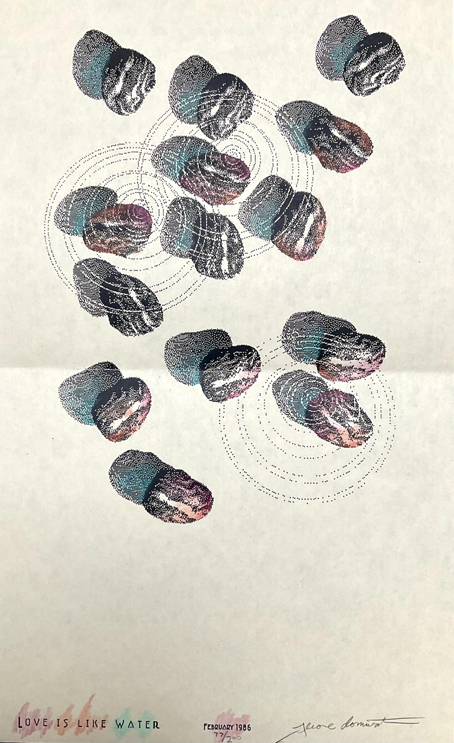
Art print by Jerome from February 1986. Photo courtesy of Dave Joly.
Sadly, Jerome passed away in 2017. My condolences to his family.
| GAME | SYSTEM | COMPANY | STATUS |
| exhibit quiz games | Atari 400/800, C-64 | American Museum of Science + Energy | unknown |
| Sketch | Atari 400/800 | Atari | unreleased |
| Raiders of the Lost Ark | Atari VCS/2600 | Atari | released |
| E.T. | Atari VCS/2600 | Atari | released |
| Krull | Atari VCS/2600 | Atari | released |
| Millipede | Atari VCS/2600 | Atari | released |
| RealSports Soccer | Atari VCS/2600 | Atari | released |
| Taz | Atari VCS/2600 | Atari | released |
| Asterix | Atari VCS/2600 | Atari | released |
| Dumbo's Flying Circus | Atari VCS/2600 | Atari | unreleased |
| Saboteur / The A-Team | Atari VCS/2600 | Atari | unreleased |
| RealSports Baseball | Atari 5200 | Atari | released |
| Jungle Hunt | Atari 5200 | Atari | released |
| Pengo | Atari 5200 | Atari | released |
| Jungle Hunt | PC | Atari | released |
| OS graphics | Atari 520ST | Atari | released |
| Star Raiders | Atari 520ST | Atari | released |
| NeoChrome Apple | Atari 520ST | Atari | released |
| Jurassic Park (Creative Manager) | Sega CD | Sega | released |